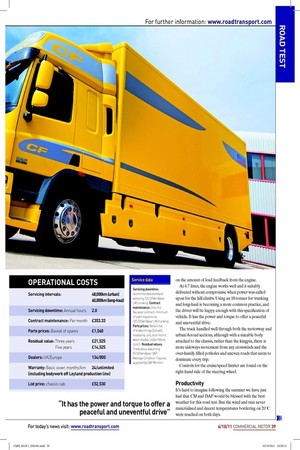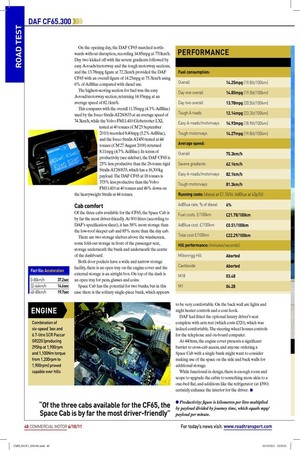For the second time in as many months, CM has
Page 27

Page 29

Page 30

Page 31

If you've noticed an error in this article please click here to report it so we can fix it.
tested a truck ‘outside of the box’ . While the editor usually considers issuing a written warning for using such
a term, we have our reasons.
Putting the Iveco Stralis 26-tonner through the two-day Scottish test route (CM 22 September) threw up some interesting results in terms of fuel economy and productivity compared with the 40and 44-tonne trucks we normally test on that route. Also geared up for the long-haul is this DAF CF65.300 with Space Cab, so we thought: “Why not?”
The 18-tonner is the best-selling rigid: it’s the perfect make weight within a mixed leet, and it’s no accident that every truck rental company is well stocked with 18-tonners with sleeper cabs.
As this CF is the frst 18-tonner to go around the route, like-for-like context is not an option, so we will compare it directly with the 26-tonne Stralis and previously tested trucks at 40 and 44 tonnes respectively. Over the course of time, CM hopes to build this portfolio to broaden the productivity chart and see how running costs, purchase price, and of course payload and fuel economy compare.
The CF65 4x2 rigid is powered by the 6.7-litre Euro-5 SCR Paccar GR220 engine, complete with six cylinders and vertical in-line turbocharger with intercooling. It delivers 295hp from 1,900rpm, and 1,100Nm torque from 1,200rpm to 1,900rpm. Alternatives in the GR range are: GR165 (221hp/850Nm), GR184 (246hp/950Nm) and GR210 (281hp/1,100Nm).
Operators would do well to look at the GR210 engine as an alternative at 18 tonnes, and if it’s for a drawbar application, weigh up the options by looking at the PR 9.2-litre instead, to cope with the extra weight and axles.
Standard transmission is the six-speed manual from ZF, but DAF has itted one of two options, namely the ZF ASTronic six-speed automated ’box (the other option is the nine-speed manual).
On top sits the optional Space Cab, which increases payload and cost by 95kg and £4,770 respectively. Standard is the day cab. The boxvan bodywork is built on the Leyland production line.
List price for the chassis cab (with day cab) is £52,530 (plus VAT). Optional extras include the Space Cab, Alcoa alloy wheels, rear air suspension, night heater, front camera system, roof spoiler with side collars, larger fuel and AdBlue tanks, wood-effect dashboard, luxury driver’s seat and refrigerator. All in all, it totals £69,440 as tested.
On the road
No current CM tester remembers the last time a six-speed tackled the Shap hill climb on a road test, but it’s unlikely to have been as effortless as the ZF in this truck. Manufacturers appear divided over which transmission is best suited to 18-tonners. DAF and Renault go for six speeds, while MAN specs a 12-speed automated transmission for its TGM, and others specify nine speeds.
Any concerns that a six-speed might reveal gaps in the driveline between third and fourth and again between ifth gear and the overdrive top gear were ably dismissed by the broad 1,100Nm torque band that stretches over 700rpm.
Tramping up the M6 was done exclusively in top gear, so there was no need to use the controls on the righthand stalk off the steering column. At 40mph on singlecarriageway roads, it’s a different story as revs sit in and around 1,400rpm.
Peak torque starts at 1,200rpm before it falls away to approximately 800Nm at 1,000rpm, so at 40mph and with 200rpm in the bank CM found that unless a hill climb veered towards the prolonged or arduous, we could nip over the apex in top without losing somewhere between 2mpg and 3mpg for an unnecessary gear change. Attempts to lug below 1,000rpm (it happened twice) saw momentum drop right down and a change was needed to recover lost speed. The driver needs to focus on the 1,200rpm mark and judge each climb on merit.
At 50mph, the truck sits at approximately 1,600rpm in top gear, so only being baulked or tackling something close to Snowdonia would require the driver to drop a gear. Peak power only starts to kick in at 1,900rpm, so for the most part the truck is using between 190hp and 215hp of the 295hp on offer, if you can keep the revs between 1,200rpm and 1,400rpm.
Keeping revs down helps save fuel and to do this manual intervention on the gearbox is needed, as CM discovered in the Iveco Stralis test. It prevents unwanted changes on shallow hill climbs by over-zealous gearboxes erring on the side of caution.
It takes a while to get the hang of it, but situations like braking, negotiating urban areas and roundabouts/trafic lights can be controlled admirably by automation. On the open road and accelerating up through the box, the driver can easily switch to manual and use their wealth of experience to pre-judge changes economically, rather than wait for the automated transmission to change gear based on the amount of load feedback from the engine.
At 6.7 litres, the engine works well and it suitably delivered without compromise when power was called upon for the hill climbs. Using an 18-tonner for trunking and long-haul is becoming a more common practice, and the driver will be happy enough with this speciication of vehicle. It has the power and torque to offer a peaceful and uneventful drive.
The truck handled well through both the motorway and urban/A-road sections, although with a sizeable body attached to the chassis, rather than the kingpin, there is more sideways movement from any crosswinds and the over-hastily illed potholes and uneven roads that seem to dominate every trip.
Controls for the cruise/speed limiter are found on the right-hand side of the steering wheel.
Productivity
It’s hard to imagine following the summer we have just had that CM and DAF would be blessed with the best weather for this road test. But the wind and rain never materialised and decent temperatures bordering on 20°C were reached on both days. On the opening day, the DAF CF65 marched northwards without disruption, recording 14.85mpg at 77.0km/h. Day two kicked off with the severe gradients followed by easy A-roads/motorway and the tough motorway sections, and the 13.78mpg igure at 72.2km/h provided the DAF CF65 with an overall igure of 14.25mpg at 75.3km/h using 6% of AdBlue compared with diesel use.
The highest-scoring section for fuel was the easy A-road/motorway section, returning 14.93mpg at an average speed of 82.1km/h.
This compares with the overall 11.35mpg (4.3% AdBlue) used by the Iveco Stralis AT260S33 at an average speed of 74.3km/h, while the Volvo FM11.410 Globetrotter LXL tested at 40 tonnes (CM 23 September 2010) recorded 8.40mpg (5.2% AdBlue), and the Iveco Stralis AT450 tested at 44 tonnes (CM 27 August 2009) returned 8.11mpg (4.7% AdBlue). In terms of productivity (see sidebar), the DAF CF65 is 25% less productive than the 26-tonne rigid Stralis AT260S33, which has a 16,300kg payload. The DAF CF65 at 18 tonnes is 37.5% less productive than the Volvo FM11.410 at 40 tonnes and 46% down on the heavyweight Stralis at 44 tonnes.
Cab comfort
Of the three cabs available for the CF65, the Space Cab is by far the most driver-friendly. At 900 litres (according to DAF’s speciication sheet), it has 58% more storage than the low-roof sleeper cab and 85% more than the day cab.
There are two storage shelves above the windscreen, some fold-out storage in front of the passenger seat, storage underneath the bunk and underneath the centre of the dashboard.
Both door pockets have a wide and narrow storage facility, there is an open tray on the engine cover and the external storage is an airtight box. On top of the dash is an open tray for pens, glasses and coins.
Space Cab has the potential for two bunks, but in this case there is the solitary single-piece bunk, which appears to be very comfortable. On the back wall are lights and night heater controls and a coat hook.
DAF had itted the optional luxury driver’s seat complete with arm rest (which costs £320), which was indeed comfortable. The steering wheel houses controls for the telephone and on-board computer.
At 440mm, the engine cover presents a signiicant barrier to cross-cab access, and anyone ordering a Space Cab with a single bunk might want to consider making use of the space on the side and back walls for additional storage.
While functional in design, there is enough room and scope to upgrade the cabin to something more akin to a one-bed lat, and additions like the refrigerator (at £590) certainly enhance the interior for the driver. n ● Productivity: igure is kilometres per litre multiplied by payload divided by journey time, which equals mpg/ payload per minute.












































